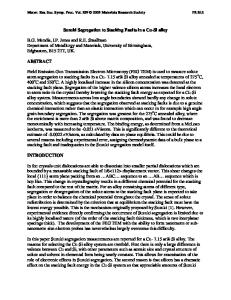Twin Boundaries and Stacking Faults in Monazite (Monoclinic LaPO 4 )
- PDF / 828,486 Bytes
- 5 Pages / 612 x 792 pts (letter) Page_size
- 112 Downloads / 363 Views
P4.8.1/N4.8.1
Twin Boundaries and Stacking Faults in Monazite (Monoclinic LaPO4) Randall S. Hay Air Force Research Laboratory Materials and Manufacturing Directorate WPAFB, OH 45433-6533, U.S.A. ABSTRACT Monazite (LaPO4) was indented at room temperature. Deformation twin boundaries and stacking faults were characterized by high resolution transmission electron microscopy. Kinked deformation twins were also characterized and analyzed. Three types of stacking faults associated with climb-dissociated partial dislocations were observed. Two were found on twin boundaries, and a third in the lattice. Formation mechanisms are discussed. The superimposition of stacking faults along twin boundaries during deformation twinning and the glide of climb-dissociated partial dislocations allowed by stacking fault migration are discussed. The possible relationship between the formation mechanisms for these defects and the lowtemperature recrystallization and self-annealing of defects in monazite is considered. INTRODUCTION Monazite (LaPO4) is monoclinic with lattice parameters a = 0.683 nm, b = 0.706 nm, c = 0.648 nm, and β = 103.2º.(1) It is refractory (mp 2072ºC), relatively soft (5 GPa), machinable, and stable with many common oxides.(2-5) Monazite is a member of a large structural family that includes xenotime, scheelite, fergusonite, vandates, and other refractory crystal structures.(2, 6) The mechanical properties of monazite promote distributive damage mechanisms in ceramic fiber-matrix composites (CMCs).(2, 7-9) Deformation during pullout or push in of fibers in CMCs is localized in monazite coatings, without observable affects on the surrounding fiber or matrix.(7, 10) These deformation mechanisms include cleavage fracture, dislocation slip, and twinning, and they are critical to the mechanical functionality of the coating. Wear of monazite during room-temperature fiber push-out forms fine-grained microstructures that suggest recrystallization.(10) The large lattice parameters, low symmetry, and relative complexity of the monazite crystal structure make it useful for testing models for deformation mechanisms and interface structures developed for simpler materials with higher symmetry. For these reasons the fundamental deformation mechanisms of monazite and similar materials are of great interest. Monazite deformation mechanisms are the subject of recent studies. Five deformation twin modes, including an unusual kinked deformation twin, slip systems associated with deformation twinning, and climb-dissociated dislocations were identified.(11-15) This paper reviews some unusual characteristics of twin boundaries and stacking faults introduced during deformation of this refractory, low-symmetry material. Formation mechanisms and the significance to mechanical behavior are discussed. EXPERIMENTS Polycrystalline monazite (5 – 20 µm grain size) was indented at room temperature with a 3 mm spherical tungsten carbide indenter using a 20 kg load.(5, 13) TEM samples of regions underneath the indents were prepared as previously descr
Data Loading...









